Yukon |
|
|
|
| Übersicht – Contents: | |
Diese Seite ist Teil des Projektes
Yukon |
|
|
|
| Übersicht – Contents: | |
Flagge – Flag: |
|
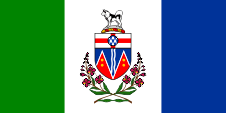 |
Flagge des Yukon Territoriums – flag of the Yukon Territory, Seitenverhältnis – ratio = 1:2, Quelle/Source, nach/by: Wikipedia (D)   |
|
|
|
historische Flaggen – historical Flags: |
|
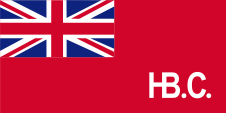 |
ca.1810–1869, |
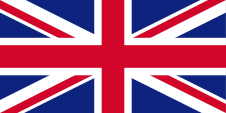 |
1870–1965, Union Flag → quasi Nationalflagge/national flag, Flagge von Großbritannien – flag of United Kingdom, Seitenverhältnis – ratio 1:2, Quelle/Source, nach/by: Wikipedia (EN), thecanadianencyclopedia.ca    |
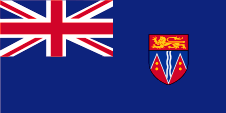 |
1934–1956, Flagge der Regierung (Staatsflagge) – flag of the government (state flag), Quelle/Source, nach/by: World Statesmen |
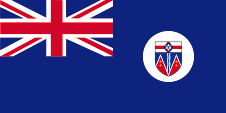 |
1956–1967, Flagge der Regierung (Staatsflagge) – flag of the government (state flag), Quelle/Source, nach/by: World Statesmen, Wikipedia (D) |
|
|
|
Bedeutung/Ursprung der Flagge – Meaning/Origin of the Flag: |
|
| Die heutige Flagge des Yukon-Territoriums wurde am 01.12.1967 eingeführt zeigt drei vertikale Streifen in Grün, Weiß und Blau. Der weiße Streifen trägt das Wappen des Territoriums in der Mitte. Das Grün steht für die Wälder, das Weiß für das Eis und den Schnee, und das Blau für die Gewässer. | The
today's flag
of the Yukon Territory was introduced on 1st of December in 1967 and shows three vertical stripes in green, white and
blue. The white stripe carrys in the middle the coat of arms of the
territory. The green stands for the woods, the white for ice and snow and the blue for the waters. |
| Das Yukon-Territorium war 1898 durch Ausgliederung aus den Nordwest-Territorien gegründet worden. | The Yukon Territory was founded in 1898 by outsourcing from the Northwest Territories. |
| Bis 1922 hätte von den Dienststellen der Territorien offiziell der britische Union Jack, die sogenannte Royal Union Flag, verwendet werden müssen, oder aber (ab 1922 im Prinzip nur noch) die kanadische blaue Dienstflagge, der typische Britische Blue Ensign, mit dem Wappenschild Kanadas im wehenden Ende. | Until the year 1922 there had officially been used, the British Union Jack, the so-called Royal Union Flag, by the departments of the territories , or (from 1922 nearly only) the Canadian blue official flag, the typical British Blue Ensign, with the coat of arms of Canada in the flying end. |
| Wahrscheinlich hat man sich im Yukon-Territorium an die Regeln gehalten, zumal ein Territorium direkt der kanadischen Regierung untersteht. | It is believed that in the Yukon Territory the flag-rules were adhered to, especially because a territory is subordinated directly under the Canadian government. |
| Dennoch hatten die Behörden der Territorien eigene Siegel und später auch Wappen, die eigenmächtig im wehenden Ende auf der blauen Dienstflagge platziert wurden. Für dieses Verfahren hätte eine Genehmigung der britischen Behörden vorliegen müssen, was jedoch nicht der Fall war, aber toleriert wurde. |
Nevertheless, the authorities of the territories had their
own seals and later also coats of arms, which were unauthorized placed in the flying end
of the blue official flag. A permit should have been approved by the British authorities for this procedure, this was not the case, but was tolerated. |
| So begann man um 1934 Blue Ensigns zu verwenden, die das Wappen des Territoriums im wehenden Ende zeigten. 1956 wurde das Wappen etwas abgeändert, was sich auch auf der Flagge bemerkbar machte. Zusätzlich wurde das Wappen inmitten einer weißen Scheibe im wehenden Ende der Flagge platziert. | Thus,
they began to use Blue Ensigns from around 1934,
which showed the coat of arms of the territory in the flying end. In 1956, the
coat of arms was changed slightly, which also was to see on the flag. In addition, the coat of arms was placed in the middle of a white disc in the flying end of the flag. |
| Privatpersonen hatten den Union Jack zu verwenden und ab 1892 den sog. Red Ensign, die rote Version der kanadischen Flagge mit dem Union Jack in der Oberecke und dem Wappen Kanadas im wehenden Ende. | Private individuals had to use the Union Jack and from 1892 the so-called Red Ensign, the red version of the Canadian flag with the Union Jack in the upper corner and the coat of arms of Canada in the flying end. |
| Im Zuge der allmählichen Trennung Kanadas von Großbritannien verlor der Blue Ensign als amtliches, britisches Kennzeichen seine Bedeutung und man ersetzte ihn durch neue Provinzflaggen, die von Behörden und Dienststellen der Provinzen und auch von Privatpersonen verwendet werden dürfen. So führte das Yukon-Territorium 1967 die heutige Flagge ein. | In
the course of the gradual separation of Canada from the United
Kingdom the Blue Ensign as an official British flag lost its
meaning and became replaced by new provincial flags, which may
be used by authorities and departments of the provinces and also
by private individuals. In this way, the Yukon Territory introduced the current flag in 1967. |
| Quelle/Source: Flaggen Enzyklopädie, World Statesmen, Wikipedia (D) | |
|
|
|
Wappen – Coat of Arms: |
|
 |
Wappen des Yukon-Territoriums – coat of arms of the Yukon Territory, Quelle/Source, nach/by: Wikipedia (D) |
|
|
|
| Das
Wappen des Yukon-Territoriums zeigt im oberen Teil des Wappenschildes ein
Georgskreuz, welches in der Mitte durch eine blau-weiß gefehte Scheibe
überdeckt ist. Der untere Teil des Wappenschildes ist blau mit einer
senkrechten weiß abgesetzten blauen Wellenlinie in der Mitte, in den von
unten zwei rote Keile hineinragen. Die Keile tragen je zwei goldene Punkte
an der Spitze. Die Wappenkrone wird gebildet von einer goldenen Wulst, auf
der sich ein Schneehügel befindet, auf dem wiederum ein Alaskan Malamute Hund steht.
Das Wappen wird unterhalb durch lokale Pflanzen begrenzt. Die roten Keile mit den goldenen Punkten stellen die goldhaltigen Gebirge dar, und die Wellenlinie die zahlreichen Flüsse des Landes. Die goldenen Punkte stehen für die reichen Goldfunde, die hier gemacht wurden. |
The coat
of arms of the Yukon Territory shows in the upper part of the blazon a St.
George's Cross which is covered in the middle by a blue-white structured
disk. The lower part of the blazon is blue with a vertical white bordered
blue wave line in the middle, in that one stand out from underneath two red
wedges. The wedges carry per two golden points in the top. The crest is made by a golden
torus, on which is positioned a snow hill , on which on the contrary stands
an Alaskan Malamute Dog. The coat of arms is below finited by local plants. The red
wedges with the golden points represent the gold-bearing mountains and the
wave line the numerous rivers of the country. The golden dots stand for the
rich gold finds that were made here. |
| Quelle/Source: Wikipedia (D) | |
|
|
|
Landkarte – Map: |
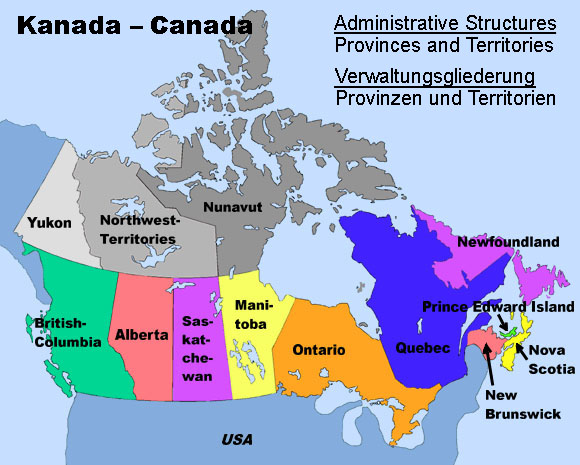 |
| Landkarte/Map: Volker Preuß |
|
|
Zahlen und Fakten – Numbers and Facts: |
|
|
|
|
|
|
|
|
|
|
|
|
|
|
|
|
|
|
|
|
|
Geschichte: |
| 1670 ·
englische Pelzhändler gründen die Hudson's Bay Company (HBC), die HBC
kolonisiert in der Folgezeit ganz Kanada zwischen Neufrankreich den Rocky
Mountains, Labrador und dem Nordrand der Hudson-Bucht 1842 · Pelzhändler der HBC durchstreifen das Gebiet 1869 · die Hudson's Bay Company (HBC) überträgt alle ihre territorialen und Hoheitsrechte an das britische Dominion Kanada, das Gebiet des heutigen Yukon-Territoriums gehört zunächst zu den Nordwest-Territorien 1880 · erste Goldfunde in Yukon 1886 · Yukon, im äußersten Nordwesten, wird ein eigener Distrikt innerhalb der Nordwest-Territorien 1887 · Gründung der Stadt Dawson (später Hauptstadt) 1895 · Bildung des Yukon-Territoriums durch Herauslösung des Distrikts aus den Nordwest-Territorien 1896 · Entdeckung großer Goldvorkommen bei Bonanz Creek am Klondike-Fluss 1905 · Ende des Goldbooms im Yukon-Territorium 1952 · die Stadt Whitehorse wird anstelle von Dawson Hauptstadt des Yukon-Territoriums 2003 · Umbenennung in "Yukon" |
|
|
History: |
| 1670 ·
English furriers establish the Hudson's Bay Company (HBC), the HBC colonizes
in the afteryears whole Canada between New France, the Rocky Mountains,
Labrador and the northern rand of the Hudson Bay 1842 · furriers of the HBC range the region 1869 · the Hudson's Bay Company (HBC) cedes all their territorial rights and prerogatives to the British Dominion of Canada, the area of the today's Yukon Territory belongs initially to the Northwest Territories 1880 · initial gold finds in Yukon 1886 · Yukon, in the outer northwest, becomes an own district within the Northwest Territories 1887 · foundation of Dawson City (afterward capital) 1895 · establishment of the Yukon Territory by dividing of the district off the Northwest Territories 1896 · discovery of big gold finds near Bonance Creek on the Klondyke River 1905 · end of the gold rush in the Yukon Territory 1952 · Whitehorse City becomes capital of the Yukon Territory instead of Dawson City 2003 · renamed in "Yukon" |
| Quelle/Source: Atlas zur Geschichte, World Statesmen, Wikipedia (D), Discovery '97 |
|
|
Ursprung des Landesnamens – Origin of the Country's Name: |
|
| Der Name des Territoriums geht auf den gleichnamigen Fluss zurück, der zentral durch das Land fließt. In der Sprache der Gwich'in-Indianer (auch: Gwitchin, Kutchin) heißt er "yu-kun-ah", was als "großer Fluss" übersetzt werden kann. Im Jahre 2003 wurde das "Yukon Territory" in "Yukon" umbenannt. | The name of the territory goes back to the river of the same name, which flows centrally through the country. In the language of the Gwich'in Indians (also: Gwitchin, Kutchin) he is called "yu-kun-ah", which can be translated as "big river". In 2003, the "Yukon Territory" was renamed in "Yukon". |
| Quelle/Source: Wikipedia (D) | |
|
|
|